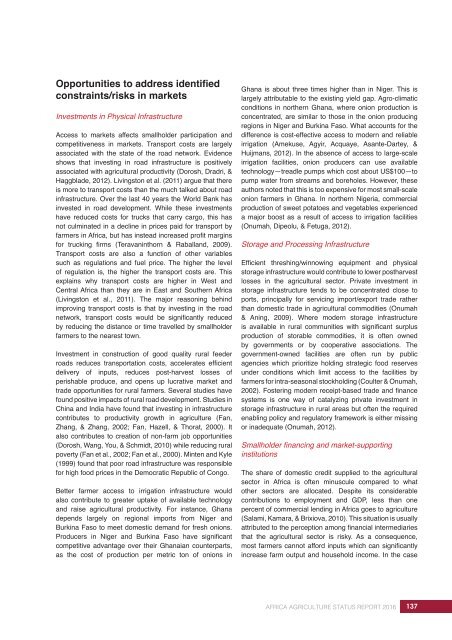AFRICA AGRICULTURE STATUS REPORT 2016
AASR-report_2016-1
AASR-report_2016-1
You also want an ePaper? Increase the reach of your titles
YUMPU automatically turns print PDFs into web optimized ePapers that Google loves.
Opportunities to address identified<br />
constraints/risks in markets<br />
Investments in Physical Infrastructure<br />
Access to markets affects smallholder participation and<br />
competitiveness in markets. Transport costs are largely<br />
associated with the state of the road network. Evidence<br />
shows that investing in road infrastructure is positively<br />
associated with agricultural productivity (Dorosh, Dradri, &<br />
Haggblade, 2012). Livingston et al. (2011) argue that there<br />
is more to transport costs than the much talked about road<br />
infrastructure. Over the last 40 years the World Bank has<br />
invested in road development. While these investments<br />
have reduced costs for trucks that carry cargo, this has<br />
not culminated in a decline in prices paid for transport by<br />
farmers in Africa, but has instead increased profit margins<br />
for trucking firms (Teravaninthorn & Raballand, 2009).<br />
Transport costs are also a function of other variables<br />
such as regulations and fuel price. The higher the level<br />
of regulation is, the higher the transport costs are. This<br />
explains why transport costs are higher in West and<br />
Central Africa than they are in East and Southern Africa<br />
(Livingston et al., 2011). The major reasoning behind<br />
improving transport costs is that by investing in the road<br />
network, transport costs would be significantly reduced<br />
by reducing the distance or time travelled by smallholder<br />
farmers to the nearest town.<br />
Investment in construction of good quality rural feeder<br />
roads reduces transportation costs, accelerates efficient<br />
delivery of inputs, reduces post-harvest losses of<br />
perishable produce, and opens up lucrative market and<br />
trade opportunities for rural farmers. Several studies have<br />
found positive impacts of rural road development. Studies in<br />
China and India have found that investing in infrastructure<br />
contributes to productivity growth in agriculture (Fan,<br />
Zhang, & Zhang, 2002; Fan, Hazell, & Thorat, 2000). It<br />
also contributes to creation of non-farm job opportunities<br />
(Dorosh, Wang, You, & Schmidt, 2010) while reducing rural<br />
poverty (Fan et al., 2002; Fan et al., 2000). Minten and Kyle<br />
(1999) found that poor road infrastructure was responsible<br />
for high food prices in the Democratic Republic of Congo.<br />
Better farmer access to irrigation infrastructure would<br />
also contribute to greater uptake of available technology<br />
and raise agricultural productivity. For instance, Ghana<br />
depends largely on regional imports from Niger and<br />
Burkina Faso to meet domestic demand for fresh onions.<br />
Producers in Niger and Burkina Faso have significant<br />
competitive advantage over their Ghanaian counterparts,<br />
as the cost of production per metric ton of onions in<br />
Ghana is about three times higher than in Niger. This is<br />
largely attributable to the existing yield gap. Agro-climatic<br />
conditions in northern Ghana, where onion production is<br />
concentrated, are similar to those in the onion producing<br />
regions in Niger and Burkina Faso. What accounts for the<br />
difference is cost-effective access to modern and reliable<br />
irrigation (Amekuse, Agyir, Acquaye, Asante-Dartey, &<br />
Huijmans, 2012). In the absence of access to large-scale<br />
irrigation facilities, onion producers can use available<br />
technology—treadle pumps which cost about US$100—to<br />
pump water from streams and boreholes. However, these<br />
authors noted that this is too expensive for most small-scale<br />
onion farmers in Ghana. In northern Nigeria, commercial<br />
production of sweet potatoes and vegetables experienced<br />
a major boost as a result of access to irrigation facilities<br />
(Onumah, Dipeolu, & Fetuga, 2012).<br />
Storage and Processing Infrastructure<br />
Efficient threshing/winnowing equipment and physical<br />
storage infrastructure would contribute to lower postharvest<br />
losses in the agricultural sector. Private investment in<br />
storage infrastructure tends to be concentrated close to<br />
ports, principally for servicing import/export trade rather<br />
than domestic trade in agricultural commodities (Onumah<br />
& Aning, 2009). Where modern storage infrastructure<br />
is available in rural communities with significant surplus<br />
production of storable commodities, it is often owned<br />
by governments or by cooperative associations. The<br />
government-owned facilities are often run by public<br />
agencies which prioritize holding strategic food reserves<br />
under conditions which limit access to the facilities by<br />
farmers for intra-seasonal stockholding (Coulter & Onumah,<br />
2002). Fostering modern receipt-based trade and finance<br />
systems is one way of catalyzing private investment in<br />
storage infrastructure in rural areas but often the required<br />
enabling policy and regulatory framework is either missing<br />
or inadequate (Onumah, 2012).<br />
Smallholder financing and market-supporting<br />
institutions<br />
The share of domestic credit supplied to the agricultural<br />
sector in Africa is often minuscule compared to what<br />
other sectors are allocated. Despite its considerable<br />
contributions to employment and GDP, less than one<br />
percent of commercial lending in Africa goes to agriculture<br />
(Salami, Kamara, & Brixiova, 2010). This situation is usually<br />
attributed to the perception among financial intermediaries<br />
that the agricultural sector is risky. As a consequence,<br />
most farmers cannot afford inputs which can significantly<br />
increase farm output and household income. In the case<br />
<strong>AFRICA</strong> <strong>AGRICULTURE</strong> <strong>STATUS</strong> <strong>REPORT</strong> <strong>2016</strong><br />
137


